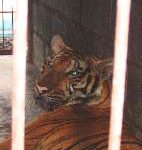Farming tigers in order to save them may turn out to be the equivalent of herding cats: an impossible undertaking with too many variables for sustained success. Yet this practice, which converts solitary predators into livestock for Chinese consumers, has been hailed as a pragmatic strategy for bringing the endangered tiger (panthera tigris) back from the brink of extinction. Wild tigers are increasingly scarce, and their population has declined sharply from an estimated 100,000 in 1900 to under 3,000 today.
At the Global Tiger Conservation Strategy Workshop in Nepal, scheduled for 26 to 30 October, 2009, the Environmental Investigation Agency (EIA) will present a new report which challenges some of the supply-side economics arguments put forth by tiger farm proponents.
Advocates of tiger farming, such as economist Barun Mitra, of New Delhi’s Liberty Institute, have argued for years that plentiful stocks of tiger parts for sale in a free market would thwart poachers and crossborder profiteering. They maintain that it is a counter-intuitive way to safeguard the dwindling number of wild tigers that have evaded dynamite, snares and poison to survive in the swamps and forests of Asia and Siberia. Two subspecies, the Caspian and Balinese tigers, already have been wiped out.
Some Chinese officials have actively promoted tiger farms since the 1980s, when trade in body parts for traditional medicine was allowed, and Beijing now seems unwilling to phase them out, despite calls to do so by the World Bank and the United Nations’ Convention on International Trade in Endangered Species (CITES).
Irregularities and inbreeding at several commercial tiger farms in Vietnam and Thailand – tourist attractions where tiger cubs are bred intensively and routinely suckled on sows – have added to the controversy over the risks of further commodifying the tiger. Bones reportedly sell for US$800 to $1,200 per kilogram on the retail black market. An adult tiger can supply five to 10 kilograms of dried bone, much more easily smuggled than its distinctive skin.
One Pacific Rim economist who has analysed the tiger trade told chinadialogue that some of the bio-economical models put forth to support tiger farming are “not only flawed scientifically, but are rigged to yield the desired results.” He added, “Tiger bone is a classic high-value, low-volume product and poaching it will always be cheaper than years of feeding a growing carnivore.” The cited statistics vary, but poaching a wild tiger costs around US$20, compared to $4,000 to raise a cub to maturity. In either case, he pointed out,“potential profits are absolutely massive, especially as new commodities are created and marketed. Take tiger bone wine. It can be diluted almost infinitely.”
When the Chinese State Forestry Administration, which oversees the country’s wildlife, quietly approved domestic trade in “lawfully-sourced tiger and leopard skins and their products” back in December 2007, conservationists grew alarmed. The wildlife trade monitoring network, TRAFFIC, recently warned that such vague wording on an official document would be pounced upon as a loophole by Chinese tiger farmers.
Xu Hongfa, the director of the Shanghai Wildlife Forensic Laboratory who also coordinates TRAFFIC’s China programmes, told the London Times: “I think these words could be used as a cover by tiger farmers to make tiger bone wine and they would try to argue that it doesn’t just refer to skins.”
Tiger bones steeped in vats of rice wine for up to nine years yield a potent pep tonic, considered a rare and prestigious gift amongst the Chinese elite. It’s viewed as a delicacy comparable to shark fin soup. Lavish banquet toasts are made with this blackmarket brew, which can be obtained inside China, although penalties for selling it are severe. Customers reportedly pay up to US$180 per half litre.
Meanwhile, farmers from Guilin to Heilongjiang provinces have stockpiled the frozen carcasses of captive tigers, either killed in fights or put down when they grew too large to control, and are eager to recoup their investment.
Compared with the 10,000 captive tigers living in zoos or private facilities in the US, and at least 5,000 “mild tigers” bred at a dozen Chinese farms, the 40 or so wild tigers remaining inside China are vastly outnumbered and likely to vanish if the demand for tiger products is stimulated. Fewer than 3,000 breeding adult tigers are left in the wild anywhere in the world, and their present habitat is only 7% of the former range, which used to extend from south India to the Russian far east and from Sumatra to northern Myanmar (Burma). The big cats are most plentiful in India, where this year’s tiger census already is underway.
India has directly challenged Chinese authorities over the ramifications of easing any restrictions on tiger trade, because the countries signed a bilateral protocol on tigers back in 1995. Keshav Varma, leader of the World Bank’s Global Tiger Initiative, announced at the 58th meeting of the Convention on International Trade in Endangered Species Standing Committee (CITES): “Having carefully weighed the economics argument, we urge the CITES community to uphold the ban on wild tiger products and for all countries to continue to ban the domestic trade of wild tigers."
Western press accounts of tiger penis aphrodisiacs or tiger brain balm to cure acne annoy practitioners of Traditional Chinese Medicine (TCM). Most spurn such folk potions, which are based on superstition, not medical theory. Even though some 100 million Chinese sufferers of arthritis might be prescribed tiger bone derivatives to ease joint inflammation if it were legal, herbal substitutions now are standard, and medical textbooks have been purged of venerable tiger-based remedies.
“I can say for sure that no one in the TCM community wants to reopen the tiger trade,” said Lixin Huang, president of the American College of Traditional Chinese Medicine in San Francisco.“There is zero demand. This tiger farming proposal is a way to make money, not to treat the sick. It confuses the public. Any use will create a threat to wild tigers. How do we monitor it to control poaching, selling and production?”
Before Chinese farmers harvest their caged tigers’ striped pelts or grind their bones for traditional medicines which have been outlawed for the past 16 years, a rethink might be in order.
Alasdair Cameron, of the EIA, contends that unleashing free market folly and legalising the trade in parts from captive bred tigers will have “disastrous consequences for the wild tiger.” He argues that a parallel trade in premium wild tiger products is bound to emerge once farmed tiger items hit the market, and that there is little incentive for tiger breeders to report inventory discrepancies, to help screen out wild tiger products or enforce the ban against their use. In fact, criminals will be tempted to process any contraband wild tiger parts through newly lawful channels.
The EIA review highlights flawed assumptions in some of the recent economic studies, noting a poor understanding of tiger biology and clandestine smuggling networks, as well as oversimplified supply and demand models. Fuzzy mathematical models that suggest tiger farming is a viable way to promote conservation have increasingly come under fire. Framing fearful symmetry in an equation is no doddle.
Economist G Cornelis van Kooten, of the University of Victoria in British Columbia, admits that he devised formulas “in spite of a paucity of data” and that factoring in a stigma effect was an afterthought, and “no empirical evidence for it exists.” Currently he’s refining his paper. “Markets where corruption is rife are tough to figure out,” he said. “Ethically I am opposed to tiger farms, just as I am to large-scale pork production. But if society permits the latter, how can you castigate the Chinese and stop tiger farming? Allowing trade might not be a disaster. Habitat destruction and lost prey is the real threat to tigers.”
The EIA report urges a cautious approach to speculative economic models and a commitment to reduce demand for tiger parts rather than boost a trade that has been in decline since 1993. It calls for tiger farms that intensively breed big cats to consolidate, declare and destroy all tiger parts , in accordance with past decisions taken by CITES. And, while several thousand wild tigers still stalk the night forests, the EIA recommends that wildlife activists draw attention to their successes and continue to raise awareness of the tigers’ plight.
Jan McGirk is a former correspondent for the Independent, who has reported on environmental issues and disasters in Asia, Latin America, and the Middle East.
Homepage image from Big Cat Rescue



